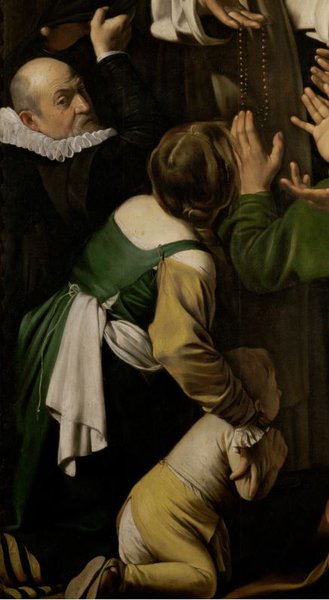Discover entertaining essays on a wide variety of artworks from our extensive collections in the section Art Stories.
A cool niche was set aside for me in this church. The flame-red curtain above my head was a last-minute idea and draped around the colossal column to my right. In this way the organisers lend a light, warm and pleasant tone to the ceremony in my honour.
I ascended my throne holding my child tightly; I did not require, indeed would not have accepted help in mounting the steps.
I know the gentlemen attired in black and white gowns well, and generally we work together harmoniously.
So it is to be today, even though the bright spotlights do blind a bit.

My son is lively; he has just learned to stand up and to walk. Right from the beginning, his powers were a mystery to me. I like it when he places his small hand around my neck, when his blonde locks gently brush my face, and when I hear a slight rumbling in his plump belly, though this does not seem to cause him any pain.
Thus I can devote myself to the people surrounding me. St. Dominic stands below to the right and casts me a rather bewildered glance. Still, he does his job consummately distributing rosaries to those kneeling at his feet. Nevertheless, just to be sure, I indicate energetically his task.
He understands.

Pope Pius V instituted the feast of the rosary following the Battle of Lepanto to recall the astounding victory of the Christian powers of the Mediterranean over the Ottoman Empire.
That is why I am here. And this is what those visit and regard my picture are meant to recall.
Just to be sure, Peter the Martyr, the monk on the other side, reminds you too of my commission.
He showed his devotion in the customary manner of the saints: the axe which once struck his brow completed his martyrdom.

I am satisfied: my instruction not to speak is being followed. Even the small child in its mother’s arms is solemn and still.
Let your hands, arms, faces and limbs speak!
One person however does not quite fit in. From here above I can only just make him out, there where he seeks the protection of St. Dominic. One does not like to speak of money here. He is looking at you, but I shall not reproach him.
On the contrary: I thank him for his efforts, for it was probably he who brought me here by paying my creator (forgive the unsaintly play on words).
And Caravaggio found exactly the right colours in Naples.